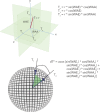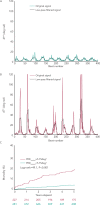Periodic Repolarisation Dynamics: A Natural Probe of the Ventricular Response to Sympathetic Activation
- PMID: 27403291
- PMCID: PMC4939306
- DOI: 10.15420/aer.2015:30:2
Periodic Repolarisation Dynamics: A Natural Probe of the Ventricular Response to Sympathetic Activation
Abstract
Periodic repolarisation dynamics (PRD) refers to low-frequency (≤0.1Hz) modulations of cardiac repolarisation instability. Spontaneous PRD can be assessed non-invasively from 3D high-resolution resting ECGs. Physiological and experimental studies have indicated that PRD correlates with efferent sympathetic nerve activity, which clusters in low-frequency bursts. PRD is increased by physiological provocations that lead to an enhancement of sympathetic activity, whereas it is suppressed by pharmacological β-blockade. Electrophysiological studies revealed that PRD occurs independently from heart rate variability. Increased PRD under resting conditions is a strong predictor of mortality in post-myocardial infarction (post-MI) patients, yielding independent prognostic value from left-ventricular ejection fraction (LVEF), heart rate variability, the Global Registry of Acute Coronary Events score and other established risk markers. The predictive value of PRD is particularly strong in post-MI patients with preserved LVEF (>35 %) in whom it identifies a new high-risk group of patients. The upcoming Implantable Cardiac Monitors in High-Risk Post-Infarction Patients with Cardiac Autonomic Dysfunction and Moderately Reduced Left Ventricular Ejection Fraction (SMART-MI) trial will test prophylactic strategies in high-risk post-MI patients with LVEF 36-50 % identified by PRD and deceleration capacity of heart rate (NCT02594488).
Keywords: myocardial infarction; periodic repolarisation dynamics; risk stratification; spatial dispersion of repolarisation; sudden death; sympathetic nervous system.
Figures
Similar articles
-
Implantable cardiac monitors in high-risk post-infarction patients with cardiac autonomic dysfunction and moderately reduced left ventricular ejection fraction: Design and rationale of the SMART-MI trial.Am Heart J. 2017 Aug;190:34-39. doi: 10.1016/j.ahj.2017.05.006. Epub 2017 May 19. Am Heart J. 2017. PMID: 28760211 Clinical Trial.
-
Risk prediction in post-infarction patients with moderately reduced left ventricular ejection fraction by combined assessment of the sympathetic and vagal cardiac autonomic nervous system.Int J Cardiol. 2017 Dec 15;249:1-5. doi: 10.1016/j.ijcard.2017.06.091. Int J Cardiol. 2017. PMID: 29121716
-
Periodic repolarization dynamics as a risk predictor after myocardial infarction: Prospective validation study.Heart Rhythm. 2019 Aug;16(8):1223-1231. doi: 10.1016/j.hrthm.2019.02.024. Epub 2019 Feb 26. Heart Rhythm. 2019. PMID: 30818092
-
Identifying high-risk post-infarction patients by autonomic testing - Below the tip of the iceberg.Int J Cardiol. 2017 Jun 15;237:19-21. doi: 10.1016/j.ijcard.2017.03.087. Epub 2017 Mar 18. Int J Cardiol. 2017. PMID: 28343763 Review.
-
Risk stratification after myocardial infarction: is left ventricular ejection fraction enough to prevent sudden cardiac death?Eur Heart J. 2013 Jul;34(26):1964-71. doi: 10.1093/eurheartj/eht109. Epub 2013 May 3. Eur Heart J. 2013. PMID: 23644180 Review.
Cited by
-
Electrocardiography Assessment of Sympatico-Vagal Balance during Resting and Pain Using the Texas Instruments ADS1299.Bioengineering (Basel). 2023 Feb 3;10(2):205. doi: 10.3390/bioengineering10020205. Bioengineering (Basel). 2023. PMID: 36829699 Free PMC article.
-
Complex Interaction Between Low-Frequency APD Oscillations and Beat-to-Beat APD Variability in Humans Is Governed by the Sympathetic Nervous System.Front Physiol. 2020 Jan 22;10:1582. doi: 10.3389/fphys.2019.01582. eCollection 2019. Front Physiol. 2020. PMID: 32038279 Free PMC article.
-
Long-Term Microgravity Exposure Increases ECG Repolarization Instability Manifested by Low-Frequency Oscillations of T-Wave Vector.Front Physiol. 2019 Dec 17;10:1510. doi: 10.3389/fphys.2019.01510. eCollection 2019. Front Physiol. 2019. PMID: 31920714 Free PMC article.
-
Beat-to-Beat Variability of Ventricular Action Potential Duration Oscillates at Low Frequency During Sympathetic Provocation in Humans.Front Physiol. 2018 Apr 4;9:147. doi: 10.3389/fphys.2018.00147. eCollection 2018. Front Physiol. 2018. PMID: 29670531 Free PMC article.
-
Diagnostic Power of Head-Up Tilt Test Enhanced by Autonomic ECG Parameters and Beat-to-Beat Hemodynamic Monitoring.Cardiol Res Pract. 2025 May 15;2025:5239630. doi: 10.1155/crp/5239630. eCollection 2025. Cardiol Res Pract. 2025. PMID: 40406056 Free PMC article.
References
-
- Lown B, Verrier RL. Neural activity and ventricular fibrillation. N Engl J Med. 1976;294:1165–70. PMID: 57572. - PubMed
-
- Cao JM, Fishbein MC, Han JB, et al. Relationship between regional cardiac hyperinnervation and ventricular arrhythmia. Circulation. 2000;101:1960–9. PMID: 10779463. - PubMed
-
- Han J, Garcia de Jalon P,, Moe GK. Adrenergic effects on ventricular vulnerability. Circ Res. 1964;14:516–24. PMID: 14169970. - PubMed
Associated data
LinkOut - more resources
Full Text Sources
Other Literature Sources
Medical
Miscellaneous







